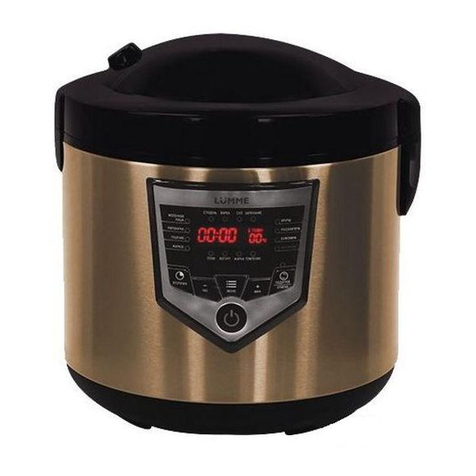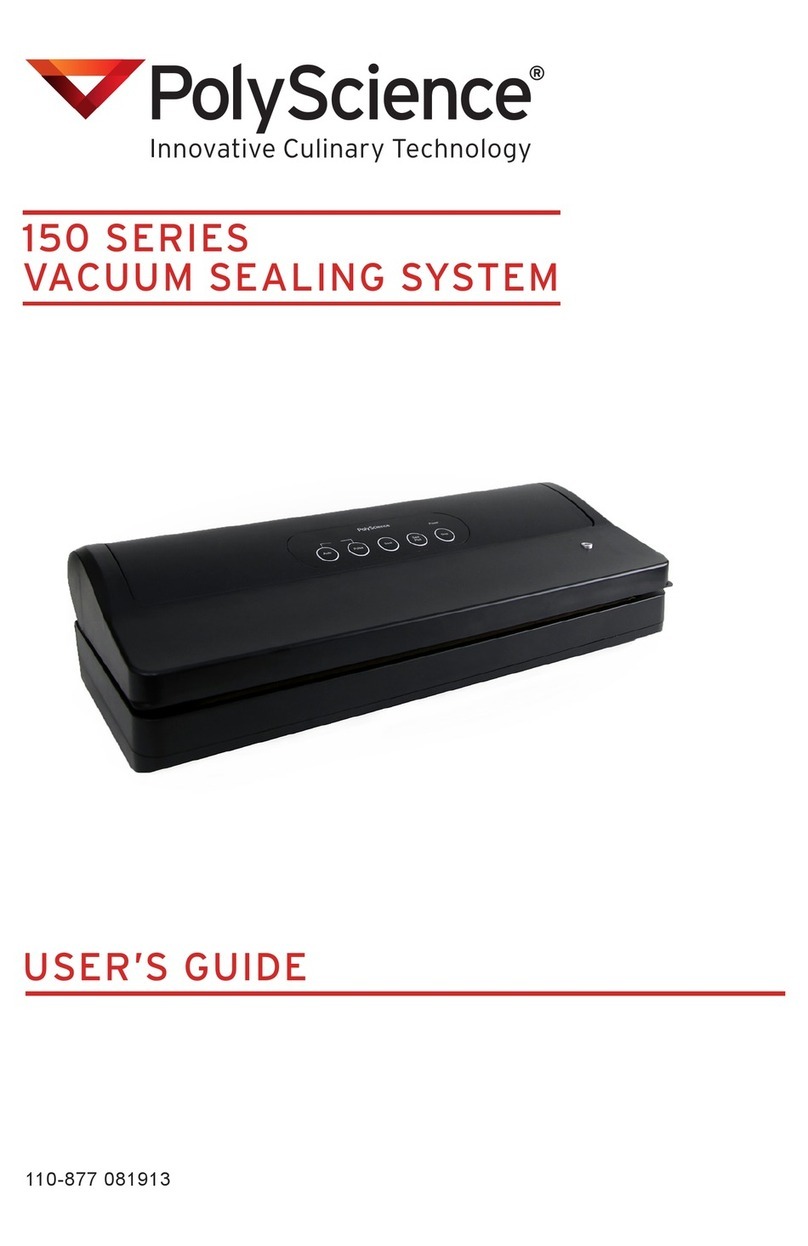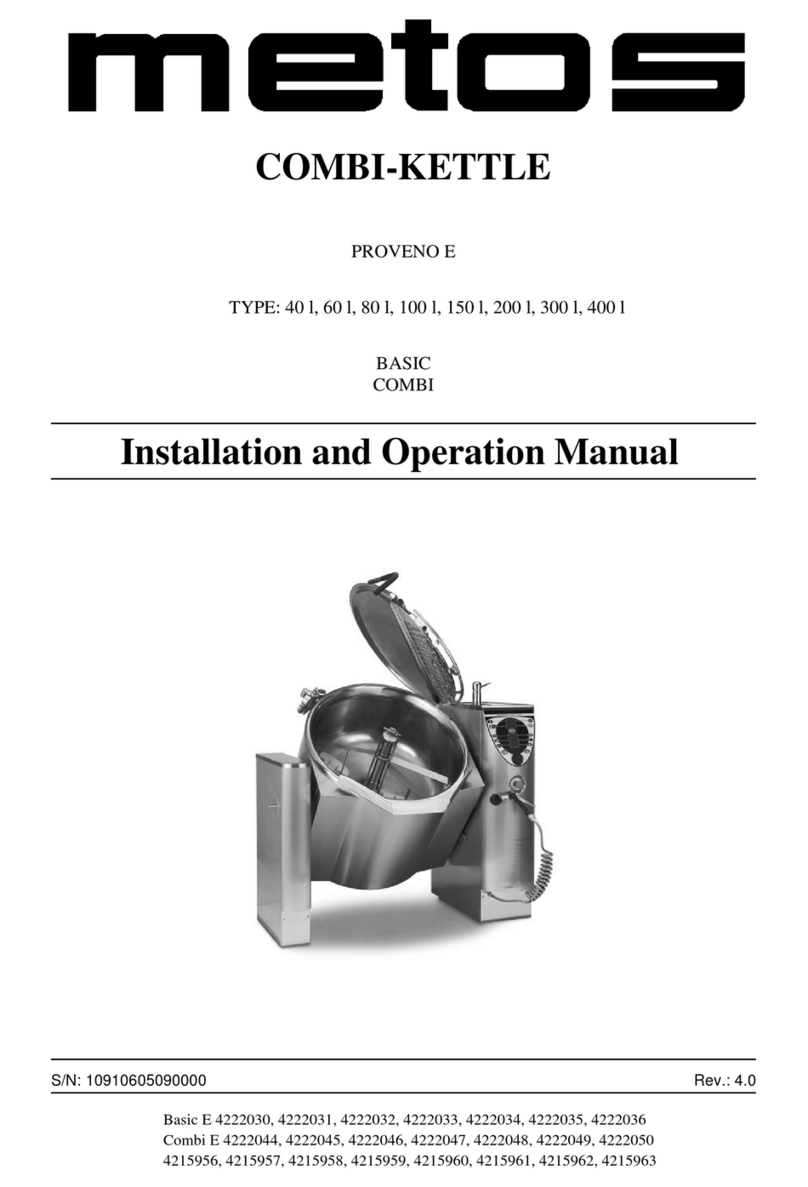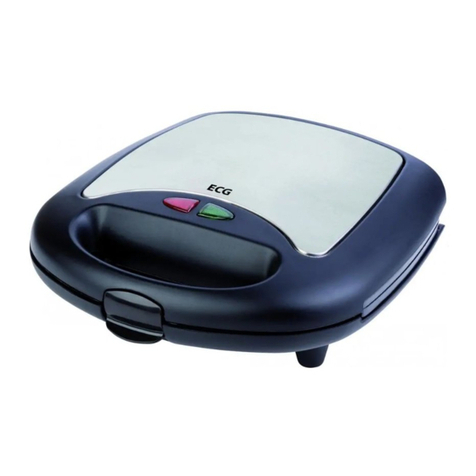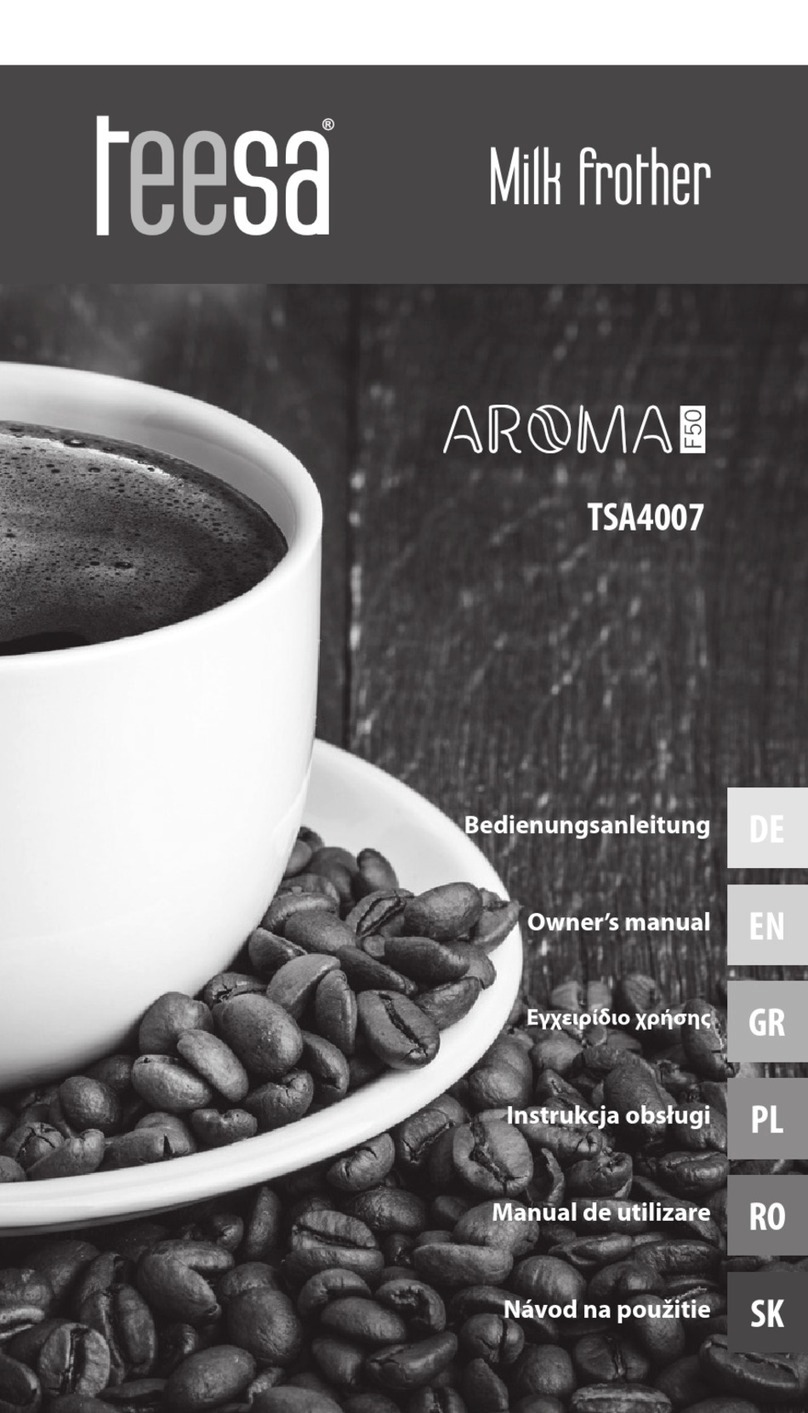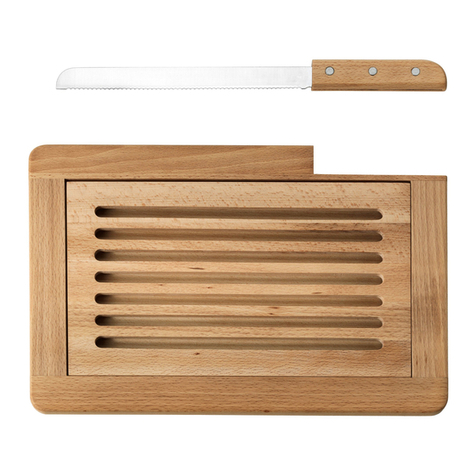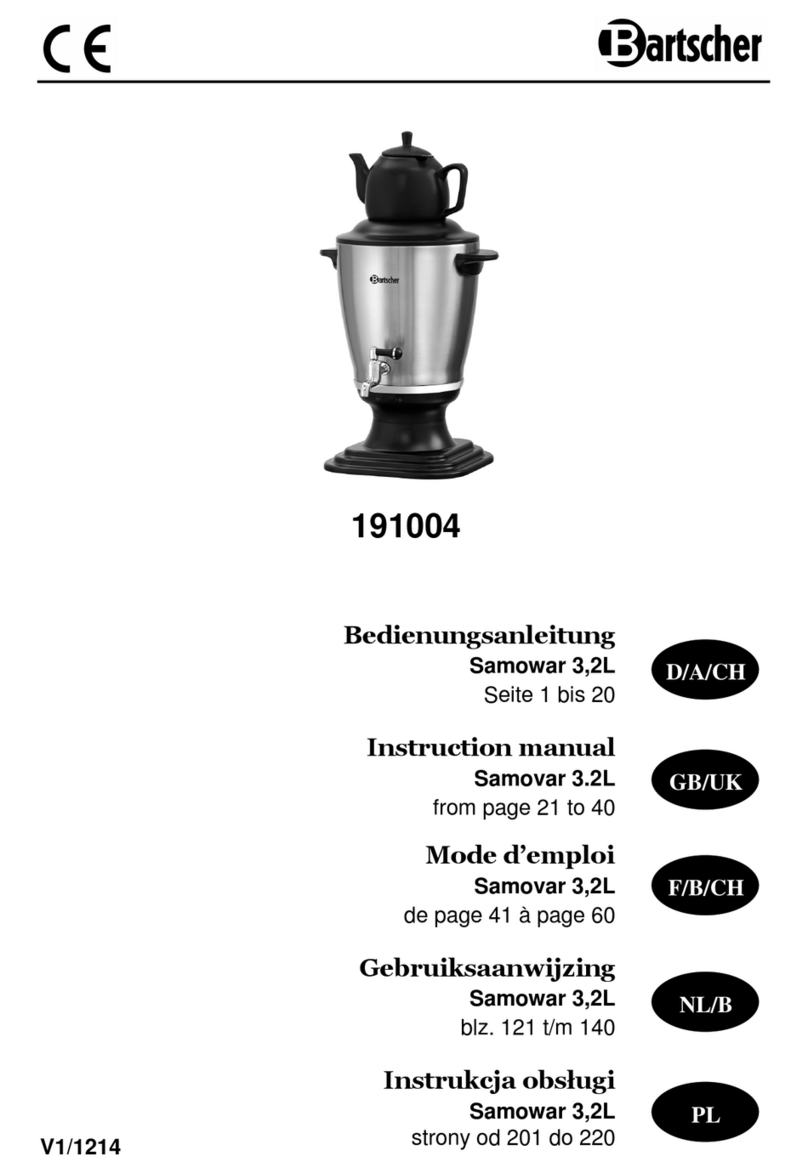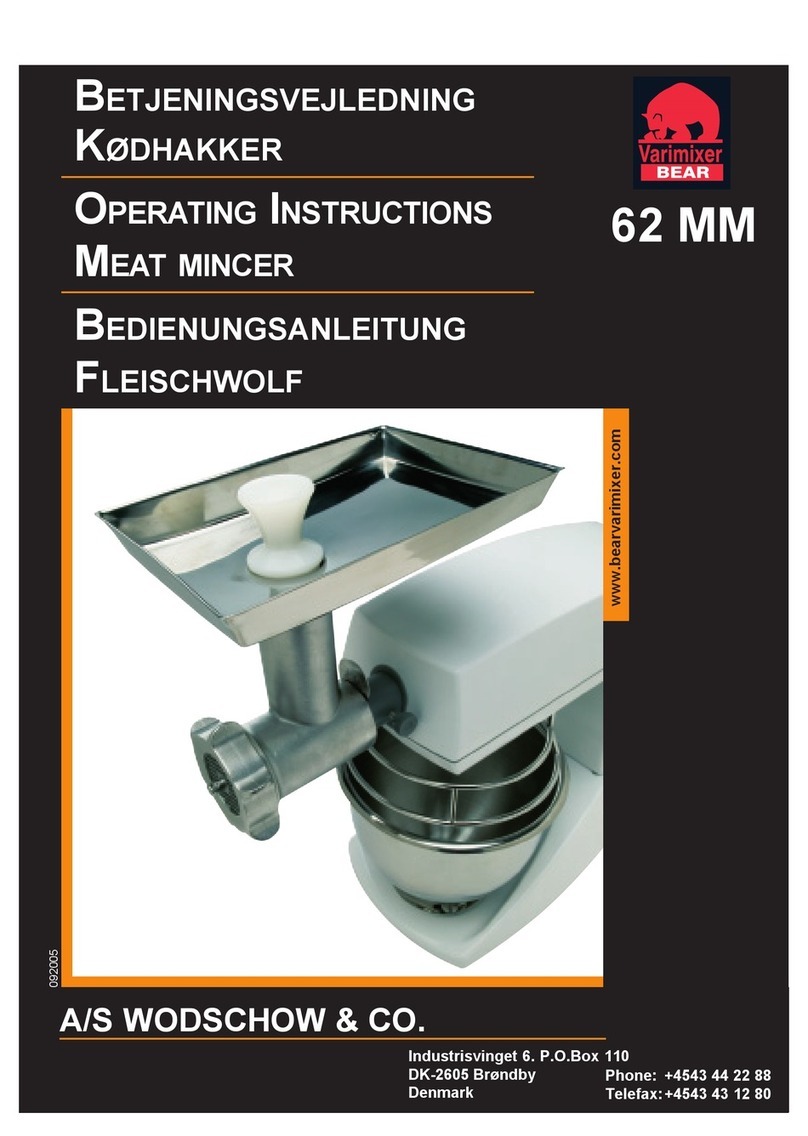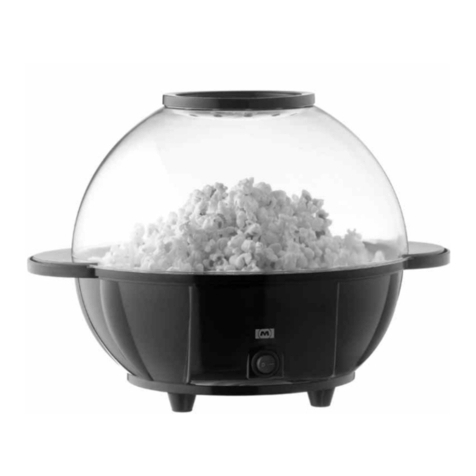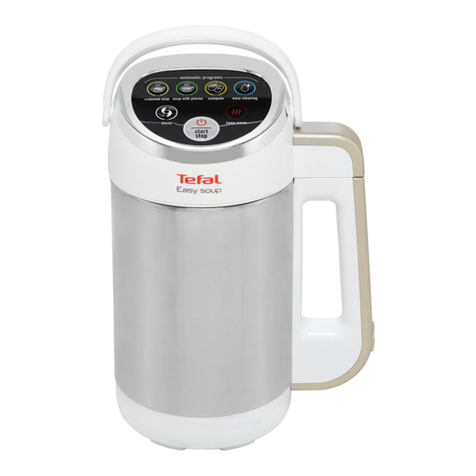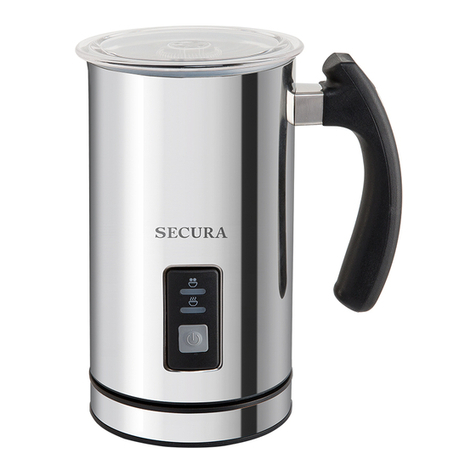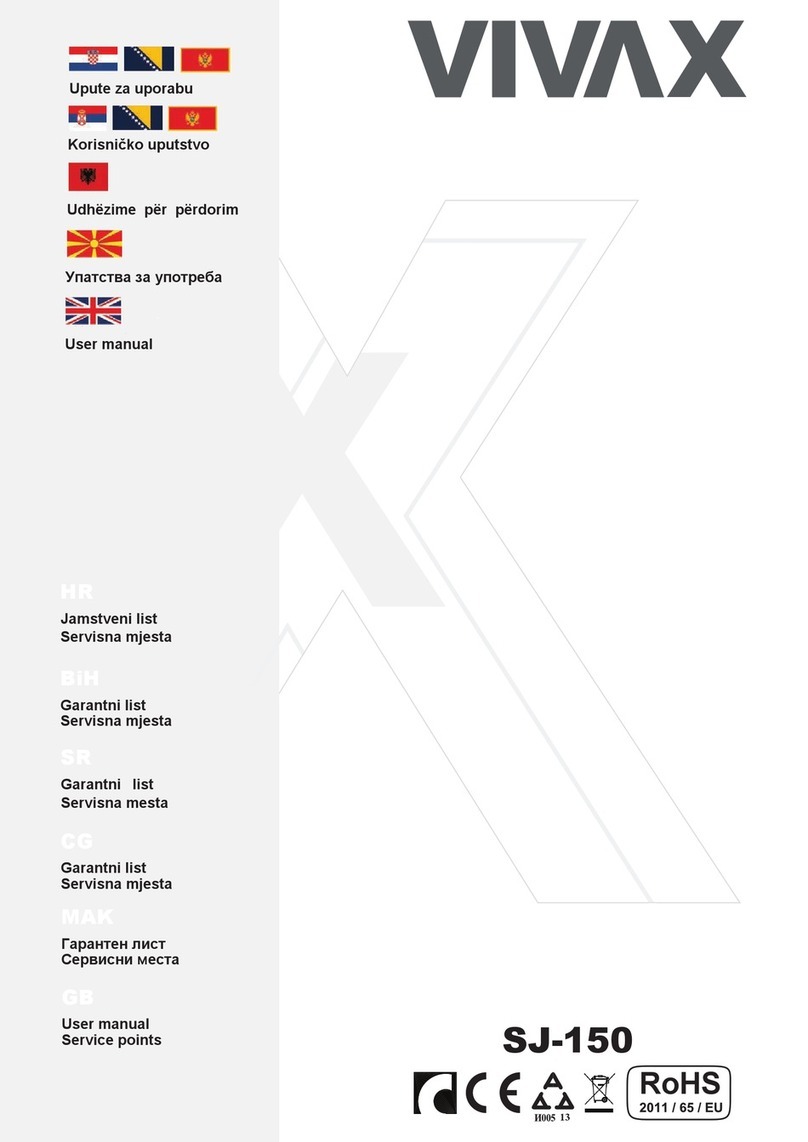Salvis VitalityEVO-Pro User manual

SALVIS VitalityEVO-Easy Pressure Steamer
SALVIS VitalityEVO-Pro Pressure Steamer
Operating instructions
en-GB
Translationof the original operating instructions
Read the operating instructions before installing and commissioning the appliance!

Table of contents page
2/ 80
1. User information 4. .................................................................
1.1 Important information about these operating instructions 4.........................
1.2 Symbols in front of the text 4...................................................
1.3 Warning icons 4..............................................................
1.4 Signal words 4...............................................................
1.5 Intended use 5...............................................................
1.6 Misuse 5....................................................................
1.7 Entering type plate data 5.....................................................
2. Safety instructions 6................................................................
3. Description of the appliance 8........................................................
3.1 Description of the functional components 8......................................
3.2 Familiarise yourself with the control/display panel 9...............................
3.2.1 Overview of control system variants 9....................................
3.2.2 Instructions for using the touch screen 10..................................
4. Commissioning 11...................................................................
4.1 Preparing the appliance for use 11...............................................
4.2 Switching on the appliance 13...................................................
4.3 Filling the cooking chamber 13..................................................
4.4 Working with the core temperature sensor (optional) 14.............................
4.5 Starting/ending the cooking process 15...........................................
4.5.1 Starting the cooking process 15..........................................
4.5.2 Ending the cooking process 16...........................................
4.5.3 Removing the containers 16.............................................
4.6 Using the pull-out shower head with automatic retraction (optional) 17................
5. Finishing up – Switch off the appliance 17..............................................
5.1 If there is a risk of frost or before long stoppage times 17...........................
6. Using operating modes and cooking programs 18........................................
6.1 Configuring the cooking process – manual settings 18..............................
6.2 Adding cooking steps/combinations 22...........................................
6.3 Using revitalisation 25..........................................................
6.4 Using cooking methods 26......................................................
6.5 Using special programs 27......................................................
6.6 Using cooking programs from the cookbook 28....................................
6.7 Working with categories (menu groups) 30........................................
6.8 Working with favourites (preferred products) 31....................................
7. Creating, changing and deleting cookbook products 33...................................
7.1 Creating, saving and assigning products 33.......................................
7.2 Changing settings for products in the cookbook 37.................................
7.3 Deleting a product from the cookbook 38.........................................
7.4 Creating and deleting categories 39..............................................
7.4.1 Creating categories 39..................................................
7.4.2 Deleting categories with products 40......................................

Table of contents page
3/ 80
8. Displaying and exporting HACCP logs 43. ..............................................
8.1 Displaying HACCP logs 43.....................................................
8.2 Exporting HACCP logs to a USB drive 44.........................................
9. Configuring the control system and user interface 45.....................................
10. Exporting and importing data 56.......................................................
10.1 Data export: Information about the data structure on the USB drive 57................
10.2 Data import: information about the "Replace/Add" key 58...........................
10.3 Exporting data – save data example 59...........................................
10.4 Importing data – replace cookbook(s) example 60..................................
11. Cleaning and care 62................................................................
11.1 Important information about stainless steel (risk of corrosion) 62.....................
11.2 Cleaning stainless steel surfaces 62.............................................
11.3 Cleaning and care of the seal on the cooking chamber door 63......................
11.4 Cleaning the cooking chamber and the drip tray 63.................................
11.5 Rinsing and cleaning the drain and valves 64......................................
12. Regenerating the water softener 65....................................................
12.1 Regeneration prompts 65.......................................................
12.2 Starting the regeneration process 65.............................................
13. Faults and troubleshooting 68.........................................................
14. Technical data 71...................................................................
15. Setup and connections 71............................................................
15.1 Transporting the appliance 72...................................................
15.2 Information about the installation site 72..........................................
15.3 Setup 73.....................................................................
15.4 Connections 74...............................................................
15.5 Water connection 74...........................................................
15.6 Water drain 75................................................................
15.7 Connecting to the electrical power supply 75......................................
15.8 Connecting to an energy optimisation unit (optional) 76.............................
15.9 Connecting to a load-shedding unit (optional) 76...................................
16. Maintenance 77.....................................................................
17. Disposing of old appliances 77........................................................
18. Translation of ECDeclaration of Conformity 78..........................................
19. Software declaration 78..............................................................

4 / 80
1. User information
Thank you for choosing a product made by SALVIS . It is very important to us that you enjoy your
SALVIS product, and find that it makes your work easier and more productive.
1.1 Important information about these operating instructions
Please read the operating instructions carefully before starting to use the appliance.
The operating instructions contain important information about correct operation, setup and in
stallation. Please pay particular attention to the information about safe use.
Always keep the documents supplied with the appliance within easy reach and pass these on to a
new owner of the appliance.
As the operating company, ensure that personnel who work with/on the appliance have access to the
operating instructions.
1.2 Symbols in front of the text
.You are requested to perform an action.
‒Bullet points or list
●Important information, sequence of operations
Note Notes that provide particularly useful information and tips
1.3 Warning icons
Warning about
danger points
Warning about dangerous
electric voltage
Warning about hot
surfaces
1.4 Signal words
DANGER
Awarning about life-threatening injuries.
WARNING
A warning about serious injuries.
CAUTION
A warning about minor to moderate injuries.
IMPORTANT
A warning about property damage.

5 / 80
1.5 Intended use
● The appliance must be used only for cooking, steaming, regenerating or heating food, or keeping
food warm.
●The appliance is for commercial use and must be operated as follows:
−By instructed and trained personnel
−With the drip tray inserted
−When appliance use is supervised
−For the purpose designated in the operating instructions
●Any other use beyond this use is considered to be a non-intended use.
●The user is solely responsible for any damage caused by a non-intended use.
●Any and all misuse of the appliance voids both the manufacturer's warranty and the manufactur
er's general liability.
●Do not make any modifications to this appliance.
1.6 Misuse
●Do not use the appliance as a storage unit or work surface.
●The appliance must not be used for heating, drying and storing objects, or for heating and melting
process materials.
●Do not place flammable objects or objects that are easily ignited into the cooking chamber.
●The appliance must not be operated outdoors.
●The following persons must not use the appliance:
−Children
−Persons with restricted physical, sensory or mental abilities
−Untrained personnel
1.7 Entering type plate data
Type plate
Please write the type plate data in the spaces
provided below before installing the appliance.
Please provide these details if you require
after-sales service for the appliance. This will
speed up the handling of your enquiry.
Type and article number: ..................
Serial number (s. no.): ....................
Production date (year of manufacture): ......

6 / 80
2. Safety instructions
● Packaged products must be cooked only in heat-resistant containers that have been approved for
food use.
●Do not store sensitive foods in the temperature range 10–70°C in the cooking chamber for pro
longed periods. Bacteria can multiply very rapidly at temperatures within this range.
●When using the start time selection function, please note: Bacteria can multiply very quickly in
food in the cooking chamber that has not been chilled or heated.
●Please observe the rules and regulations as set out by trade associations.
●Please follow the instructions for "Cleaning" in this document, see from page 62 , section 11.
DANGER! Comply with national work safety legislation to determine and assess ha
zards
● In Germany, for example, employers are required by law to assess the hazards for employees
when carrying out their work, and the health and safety measures that are necessary. A further
example is provided by the guidelines from the German trade association for operators of com
mercial kitchens.
●The employer must specify and supply employees with personal protective equipment.
WARNING! Risk of injury!
● During operation there is a risk of burns from the following:
−Hot surfaces
−Hot Gastronorm containers
−Hot cooked products
−Hot removable racks
−Hot drip trays
−Hot steam escaping when the cooking chamber door is opened
●Risk of burn injuries! Take care when opening the cooking chamber door – hot air and steam may
escape. Always open the cooking chamber door slowly and carefully. Wear waterproof and heat-
resistant protective gloves.
●During the heating-up process, steam in the cooking chamber can escape: as a result, do not
work in the cooking chamber during this process. Close the cooking chamber door before the
heating-up process.
●Risk of scalding! When removing liquid cooked products, spilled product can cause scald injuries.
Ensure that operating personnel have a clear view of the containers in the cooking chamber. The
appliance must be installed so that the height of the upper input module does not exceed 1.60
metres/63 inches.
●Remember that filled Gastronorm containers are heavy! Always work with proper back posture.
●Slip hazard! Remove water or food that has been spilt on the floor immediately.
●Crush hazard! Do not reach between the cooking chamber door and cooking chamber when
closing the cooking chamber door. Do not reach into the locking mechanism when locking the
cooking chamber door.

7 / 80
●The water softener lid must not be removed while the appliance is in use.
●The appliance must not be operated if the mains cable/mains plug is damaged. To avoid the risk
of electric shock, the mains cable/mains plug must be replaced by an authorised customer ser
vice technician or electrician.
●Do not continue to use the appliance if the control panel glass is damaged.
●Do not move appliances/platform trolleys on castors over uneven floors or over sills or protru
sions. Platform trolleys and appliances on castors can tip over when moved across uneven floors
or over door sills!
●For appliances on castors, the manoeuvrability of the appliance must be restricted enough to pre
vent any damage to its supply and waste lines. Secure the appliance again with the safety chain
after transportation (see installation instructions).
●As an appliance operator, make sure you know where the circuit breaker is located in the building
for the appliances you are operating. This means you can shut down the appliance safely in the
event of fire or damage.
IMPORTANT! Risk of damage!
● Do not heat permanently sealed containers such as cans of food. The sealed containers or cans
could explode.
●To avoid corrosion damage to the appliance, do not place any salted food or liquids into the coo
king chamber. Also see the information about adding salt to dishes on page 13 , section 4.3.
●The ambient temperature at the installation site must not fall below freezing. Otherwise, water in
the pipes and components will freeze, and this will damage the appliance. Contact the authorised
Customer Service if water-bearing components need to be drained.
●Do not spray or clean the appliance with water hoses, pressure washers, high-pressure steam
cleaners or steam cleaners.
●Do not spray foam cleaner onto front panels or appliance enclosures. Foam cleaner seeps into
the appliance, where it can then destroy components.
●If the appliance has not been used for some time,have it inspected by the authorised Customer
Serviceto ensure it is working properly.
●If you are unable to remedy faults by using the information on page 68 , section 13. “Troubleshoo
ting”, switch off the appliance and notify the authorisedCustomer Service.

8 / 80
3. Description of the appliance
● Cooking times can be set in increments of one second/minute. This ensures you achieve the best
cooking results.
●Dishes can be cooked to a precise temperature, with or without pressure. When the cooker is
pressurised, temperatures exceeding 100°C are used for cooking. This considerably reduces
cooking times, saving you time and energy. Vegetables retain their natural colours.
●Hot steam is fed into the cooking chamber according to the various operating modes and settings
made by the operator. The higher the cooking chamber temperature, the higher the chamber
pressure. The higher the cooking chamber pressure, the faster cooking completes.
●The cooking chamber door is locked during cooking methods that use a pressurised cooking
chamber. The cooking chamber door cannot be opened until the chamber is no longer pressu
rised.
●Settings are made via the touch screen.
●The control system is used to automate the cooking methods.
●The pressure steamer is equipped with a water softener. The water softener is filled at the factory
with 0.5 kg of regeneration salt. To regenerate the water softener, see page 65 , section 12..
3.1 Description of the functional components
(1) (1) Water softener lid
(2) Display/control panel
(touch screen)
(3) Left removable rack (with socket
for core temperature sensor)
(4) Pull-out shower head (optional)
(5) Core temperature sensor (op
tional)
(6) Drain screen, cooking chamber
drain
(7) Drip tray
(8) USB port (activation optional)
(9) Adjustable feet
(10) Seal on housing
(11) Cooking chamber door
(12) Seal on cooking compartment
door
(13) Rear of appliance: network port
(Ethernet/LAN)
(14) Main appliance on/off switch
(3)
(4)
(2)
(7)
(11)
(12)
(8)
(5)
(6)
(14)
(9)
(13)
(10)

9 / 80
3.2 Familiarise yourself with the control/display panel
3.2.1 Overview of control system variants
After the control system is switched on and has powered up, various user interfaces appear ac
cording to the appliance's feature level.
Control system operating features for "Pro"
The control system supports many different
operating variants:
‒Cookbook with list view
‒Cookbook with pictogram view
‒Own favourites list (preferred products)
‒Categories as list or pictograms (grouped
products)
‒20 cooking steps can be combined
‒Special programs
‒User-selectable assignments
‒Manual settings
For information about using operating modes, see
page 18 , section 6.
Example display
The operator can configure the "Input and dis
play area" to suit operational circumstances.
For information about changing "Input and dis
play area" views, see page 45 , section 9. , fig.
11 and 12
Control system operating features for
"Easy"
With operating modes:
‒ Revitalisation
‒Cooking method
‒ Manual
For information about using operating modes,
see page 18 , section 6.1 to section 6.4
Example display
The operator can configure the "Input and
display area" to suit operational circumstan
ces.
For information about changing "Input and
display area" views, see page 45 , section
9. , fig. 11 and 12
To display HACCP data, see page 43 , sec
tion 8.
Special equipment
For descriptions of additional functions pur
chased and installed, see page 27 , section 6.5
Input/display area for op
eration
Program
functions
Input/display area for op
eration
Program
functions
To display and export HACCP data, see page
43 , section 8.

10 / 80
3.2.2 Instructions for using the touch screen
Control/display panel:
Touch screen
● The appliance's control system is operated by
using the touch screen.
●The touch screen is operated by tapping the
screen with a fingertip. Only a short tap is
needed.
●Do not tap the touch screen with ballpoint pens
or other objects.
●The layout and number of symbols in the "In
put and display area" can be customised to
operator requirements. See page 45 , sec
tion 9. , figure 11 and 12.
●The screen brightness is reduced if no input is
made for a while. Tap the screen to restore the
normal screen brightness.
Easy operation
● The control system is easy to use. Tapping the
symbols takes you to the next setting option.
To practice, tap to navigate through the
menus. You can always use the back key
to return to the previous menu.
●If you tap and hold the back key the dis
play switches to the "Home" symbol The
start screen is shown when you release the
key.
●The help function provides you with additional
context-related help in the various menus. If
you tap the help key, an explanatory help
message is shown. Use the exit key to
close the help message.
Use of light grey/dark grey
Switch symbols are shown light/dark grey and
with a border depending on the various functions.
Additional function activated/deactivated
This additional function can be activated/deacti
vated by tapping the key.
‒Light grey = additional function deactivated
‒Dark grey = additional function activated
Display of possible functions
‒ Light grey = selection not possible
‒Dark grey = can be selected
Fig.: Control system Pro
Display of possible functions
Dark grey plus border =
activated
Light grey
= deac
tivated
Additional function activated/deactivated
Light grey =
selection not
possible
Additional functions

11 / 80
4. Commissioning
Proper operation requires the following:
‒The appliance must be correctly connected by the authorised Customer Service (page 71 , sec
tion 15.)
‒The built-in water softener must be configured to the existing water hardness (page 65 , sec
tion 12.).
‒The user interface – including screen brightness, warning beeps, date, language, start screen,
home screen, HACCP, cooking data – must be adjusted for the operator (from page 45 , sec
tion 9.).
.Clean the appliance inside and outside before commissioning.
●For cleaning instructions, see page 62 , section 11.
Commissioning
After being switched on for the first time, the steam generator and water softener are filled with water
automatically (duration approx. 2 min). The steam generator heating-up process then starts. (Total
duration approx. 8 min.)
Please note: The safety temperature limiter cuts off at temperatures below zero. The safety tempera
ture limiter switches on again automatically once it is warm enough again. The appliance cannot be
used until the limiter has switched on.
4.1 Preparing the appliance for use
.Check to ensure that the cooking chamber is clean and free of cleaning agent residues.
.Open the water tap.
.Switch on the mains switch upstream of the appliance.
Suspension
bolts for remo
vable rack
Drip tray
Seal
Drain screen
Right removable rack
Fitting the parts
.Fit the seal to the cooking chamber door.
.Fit the drain screen to the cooking chamber
drain.
.Hook the drip tray into place.
.Hook in the left and right removable racks.

12 / 80
Hook
Core temperature sensor
Bracket
Placement of the core temperature sen
sor if not used
.If the core temperature sensor is not requi
red for the cooking process:
‒Fix the cable to the hook
‒Place the core temperature sensor in
the bracket
●For instructions about working with the core
temperature sensor, see page 14 , section
4.4
Locking lever
Closing
mechanism
CLOSED
OPEN
Seal
Closing the cooking chamber door
WARNING!Crush hazard! Do not re
ach between the cooking chamber door
and cooking chamber when closing the
cooking chamber door. Do not reach
into the locking mechanism when
locking the cooking chamber door.
●Do not slam the cooking chamber door shut.
.Close the cooking chamber door and lock it
with the locking lever.
If steam escapes from the seal:
.Remove and clean the seal. Then rub a thin coat of a food-grade emulsion (kitchen oil) or coo
king oil onto the seal.
●If the seal is too slack, it must be replaced or the cooking chamber door must be readjusted by
Customer Service.

13 / 80
4.2 Switching on the appliance
CAUTION! Steam can escape in the cooking chamber during the heating-up process. Do not work in
the cooking chamber during the heating-up process.
.Open the water tap.
.Switch on the mains switch upstream of the appliance.
.Close the cooking chamber door.
.Switch the appliance on – press the "On/Off" key.
●The LED ring indicator lamp lights up.
●An appliance logo is displayed for approx. 1 minute on the touch screen.
●The steam system is heated up automatically (duration approx. 8 min, depending on appliance
power).
Important: allow for the waiting time. The appliance is computer-controlled.
Accordingly, do not turn the appliance on and off quickly, as this could result in malfunctions. The
computer control system needs a certain amount of time to load all of the data or to shut the system
down properly. Accordingly, wait about 30 seconds after turning the appliance off before turning it
back on again.
For instructions on product selection/changing settings, see from page 18 , section 6.
4.3 Filling the cooking chamber
● Always use heat-resistant Gastronorm containers.
●Always season your dishes with salt after the cooking process has completed to avoid corrosion
damage when using perforated plates in the cooking chamber. This also means you will need
less salt than you would if you season before the cooking process starts.
●Do not overfill the cooking chamber. When filling Gastronorm containers with food for cooking,
stop at least 10 mm below the rim.
●Grease dripping down during the cooking process must not enter the cooking chamber drain; for
these types of food, ensure that a Gastronorm container is slotted into the lowest shelf. Otherwise
there is a risk of clogging the water drainage system.
●WARNING! Hot foods can slop over. Risk of burn injuries! Observe shelf heights for liquid foods
and foods that become liquid.
●For foods that are liquid or become liquid:
−Fill the Gastronorm container no more than 2/3 full
−Only insert Gastronorm containers at levels that can be easily seen by operating personnel

14 / 80
4.4 Working with the core temperature sensor (optional)
● The internal temperature of the food being cooked is measured precisely by the core temperature
sensor. Once the configured core temperature is reached, the appliance is automatically switched
off and a buzzer sounds.
●The cooking time is deactivated if you use the core temperature function.
●The core temperature can be used in all cooking phases. Make sure that you choose a higher
core temperature from one cooking phase to the next, otherwise the cooking process will be
ended prematurely.
●Core temperature adjustment range: 0°C to 99°C.
●Benefits of the core temperature function:
−Cooking results are uniform and optimum
−Reductions to weight losses
−Overcooking is avoided
Hook
Core temperature sensor
Bracket
Using the core temperature sensor
CAUTION! Risk of burn injuries!
The core temperature sensor is hot.
Take care when removing.
Metal tip
Handle
.Insert the core temperature sensor into the
food being cooked, with the tip towards the
centre.
●The metal tip should be pushed fully into the
food being cooked (down to the handle).

15 / 80
4.5 Starting/ending the cooking process
4.5.1 Starting the cooking process
For instructions on product selection/changing settings, see from page 18 , section 6.
1
Cooking process display
Starting the cooking process
● The symbol in the key lights up green.
.Tap the "Start/Stop" key.
●The symbol in the "Start/Stop" key changes from
green to red.
●The quantity/cooking time is adjusted automati
cally. The length of the process depends on the
quantity of food in the cooking chamber. After the
quantity/cooking time has been adjusted, the speci
fied cooking process starts automatically.
●The timer runs down. The remaining time is dis
played.
●The progress bar provides a graphical display of
the elapsed time.
●You can change settings during the cooking
process.
●Core temperature function: The cooking process
does not start if the core temperature sensor is not
inserted into the food to be cooked or the target
temperature is not set. A prompt is shown on the
display panel.
Displaying the actual temperature in the cooking
chamber
.Tap the "Temperature" key.
●The actual temperature is shown for approx. 5 sec
onds.
"Start/Stop" key display legend: Green: The cooking process can be started.
Red: The timed cooking process is running. The coo
king process can be interrupted by tapping the "Start/
Stop" key.

16 / 80
4.5.2 Ending the cooking process
WARNING! Risk of scalding! Open the cooking chamber door carefully. Allow steam and hot air to
escape in a controlled manner to avoid endangering anyone.
1
Ending the cooking process
For instructions about adjusting acoustic signals, see from
page 45 , section 9. (figure 6)
●An acoustic signal sounds at the end of the cook
ing process/when pressure returns to normal.
●Pressure is normalised automatically for cooking
temperatures over 99 °C. A message "Depressuris
ing" is shown for the duration of the process.
.Open the cooking chamber door.
●The cooking parameters set previously are dis
played again.
●The symbol in the "Start/Stop" key changes from
red to green.
End of cooking
process
Opening the cooking
chamber door
● If the "Start/Stop" key is tapped before the cooking
chamber door is opened, the "Open cooking cham
ber door" prompt is shown.
●A new cooking process can only be started after
the cooking chamber door has been opened and
closed.
4.5.3 Removing the containers
WARNING! Risk of scalding! Open the cooking chamber door carefully. Allow steam and hot air to
escape in a controlled manner to avoid endangering anyone.
CAUTION! Risk of burn injuries! Caution: the core temperature sensor is hot!
.Remove the core temperature sensor from the cooked food and insert it into its holder.
●The core temperature sensor is a sensitive measuring instrument: do not let it dangle out of the
cooking chamber. Otherwise it could be damaged when the cooking chamber door is closed.
WARNING!Risk of scalding! Caution! Hot surfaces and containers! Caution! Risk of hot liquids
slopping over! Wear suitable protective clothing and protective gloves.
.Cover containers with liquid foods before removing them to prevent any risk of scalding from li
quids slopping over.
.Clean the cooking chamber if no more cooking processes are planned after the removal of the
food. Otherwise there is a risk of clogging the drain as grease solidifies. (For cleaning instruc
tions, see page 62 , section 11.).

17 / 80
4.6 Using the pull-out shower head with automatic retraction (optional)
● Use the pull-out shower head only in the cooking chamber.
●Always ensure that the water drain can handle the amount of water you spray into the chamber.
Pull-out shower head
Pushbutton for shower head
Handle
Function
●The pull-out shower head engages at se
veral positions.
●The pull-out shower head can be retracted
between these locking points.
●The locking points can be heard and felt.
●The water supply is activated when the
cooking chamber door is open.
.Guide the pull-out shower head back into
the appliance by hand during rewinding. Do
not allow it to "snap back".
●Ensure the pull-out shower head is comple
tely retracted into the appliance after use.
Otherwise, the shower head could be
damaged by the cooking chamber door.
5. Finishing up – Switch off the appliance
.Clean the appliance – see the following section 11. "Cleaning and care".
.Switch off the appliance – tap the "On/Off" key.
●After about a second: the LED ring indicator lamp goes off (standby).
●The display screen is switched off.
●The steam system pressure is normalised as it cools down.
●The appliance is still electrically live.
.Switch off the electrical main switch upstream of the appliance, or disconnect the mains plug.
.Shut off the water tap.
5.1 If there is a risk of frost or before long stoppage times
The appliance must be emptied of all water if there is a risk of frost or before long stoppage times
(e.g. seasonal use). Notify your authorised customer service representative.

18 / 80
6. Using operating modes and cooking programs
This section 6. describes all of the options. The figures and functions may deviate from the figures
shown here, depending on the features equipped for the appliance.
6.1 Configuring the cooking process – manual settings
This section (6.1) also provides you with information about basic functions and their configuration
options.
1
Starting manual settings
(Sample figure: feature level Pro with options).
.Tap the "Manual" key
●The "Settings" window is shown.
2
Changing settings/starting the cooking process
.Tap the "Start/Stop" key.
●The symbol in the "Start/Stop" key changes from
green to red.
For information about the cooking process window,
see page 15 , section 4.5.1
or change the values with the slider or the numeric
keypad:
.Using the slider: Tap the slider control and move
to the left or right.
●The value to the left of the slider changes.
.Using the numeric keypad: Tap the number to be
changed.
●The numeric keypadis displayed (see figure 3).
and configure additional functions as required:
.Tap the additional functions key.
●The "Additional functions" window is shown (see
figure 6).
3
Numeric keypad "Time"
Time selection
"Hours:minutes"
Time selection
"Minutes:seconds"
Changing values with the numeric keypad
.Enter the required value.
.Confirm the value entered with the "Enter" key.
●The numeric keypad closes. The value is saved.
Key legend:
Delete from right to left
Close numeric keypad without saving
Confirm entry and close numeric keypad

19 / 80
4
Switching from timed cooking to core temperature
For instructions about using the core temperature sensor, see
page 14 , section 4.4
There are two ways to select the core temperature
function.
1st option – Change over with the "Core tempera
ture" key next to the temperature display:
°C
.Tap the "Time/Core temperature" key.
●The symbol switches to "Core temperature".
●The display switches from time to temperature.
2nd option – Change over with the numeric keypad:
°C
.Tap the "Core temperature" key.
●The key is shaded dark grey and has a border.
●The display switches from time to temperature.
Key legend:
Symbol next to display: Time is activated.
Symbol next to display: Core temperature is ac
tivated.
In the numeric keypad: Core temperature (activated
= shaded dark grey and has a border)
In the numeric keypad: Time
5
Displaying/changing core temperature setpoint during
the cooking process
● During the cooking process, the current tempera
ture of the core temperature sensor is displayed.
.To display or change the core temperature set
point, tap "Time/Core temperature".
●The numeric keypad with core temperature set
pointis displayed.

20 / 80
6
Additional functions
Selecting additional functions
● The "AQA" key is activated permanently and can
not be deactivated.
.Tap the additional functions you want to use.
●The key is shaded dark grey and has a border.
.Use the "Enter" key to confirm the additional
functions set.
●The "Settings" window is shown again.
●The additional functions set are shown in the win
dow.
Legend for additional functions:
Output signal and message window after cooking step is complete, e.g. for basting,
seasoning or turning the food to be cooked. Affects the acoustic signal and external
signals.
Start time preselection: Pre-select start of cooking process.
To make settings, refer to the following figure 7
AQA Automatic Quantity Adjustment (quantity detection and cooking time adjustment). AQA
is activated permanently.
Close the additional functions window without confirming changes (cancel).
Confirm settings and close window.
This manual suits for next models
1
Table of contents
Other Salvis Kitchen Appliance manuals
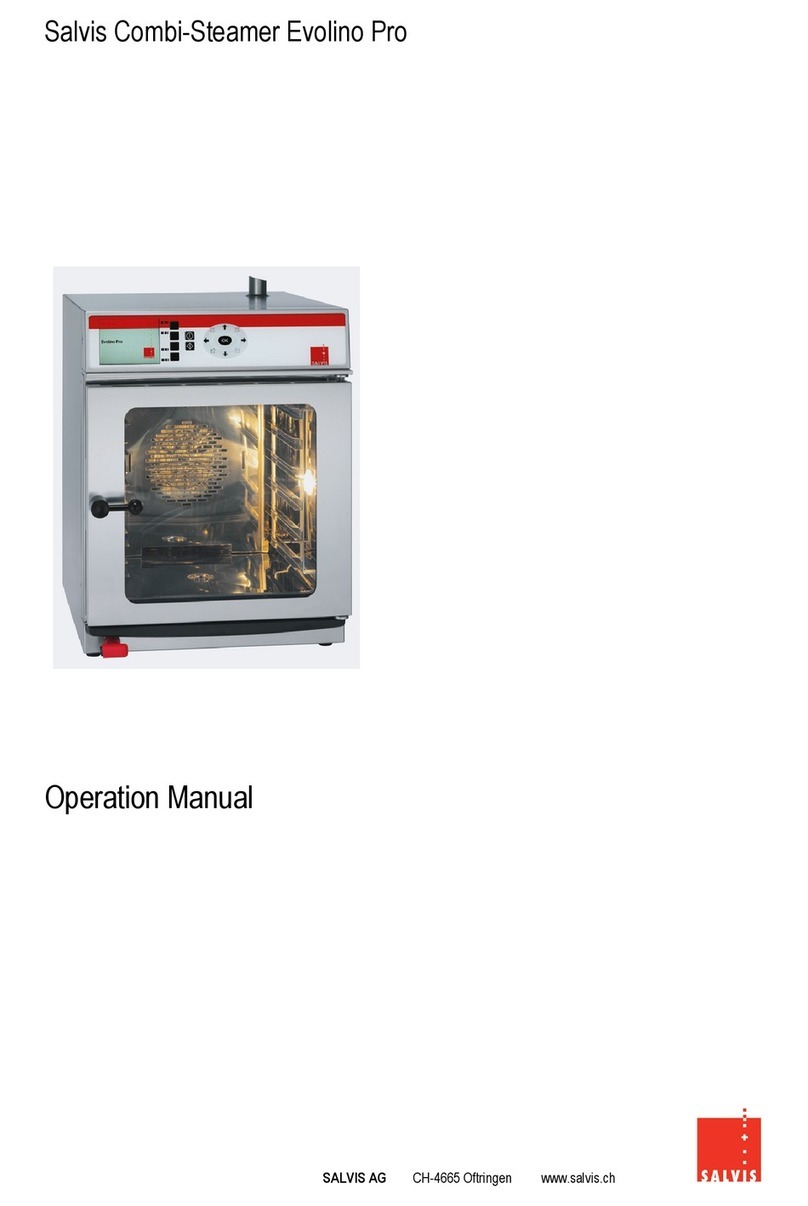
Salvis
Salvis Evolino Pro User manual
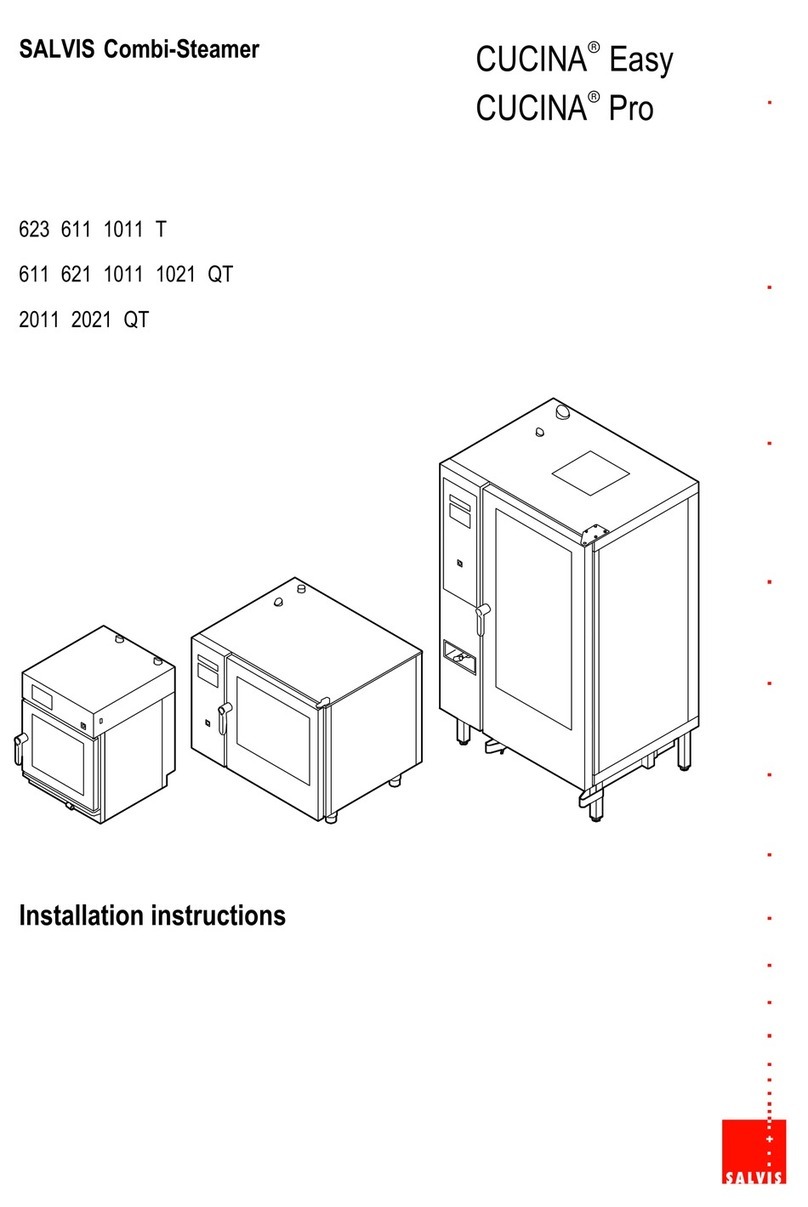
Salvis
Salvis CUCINA EASY User manual
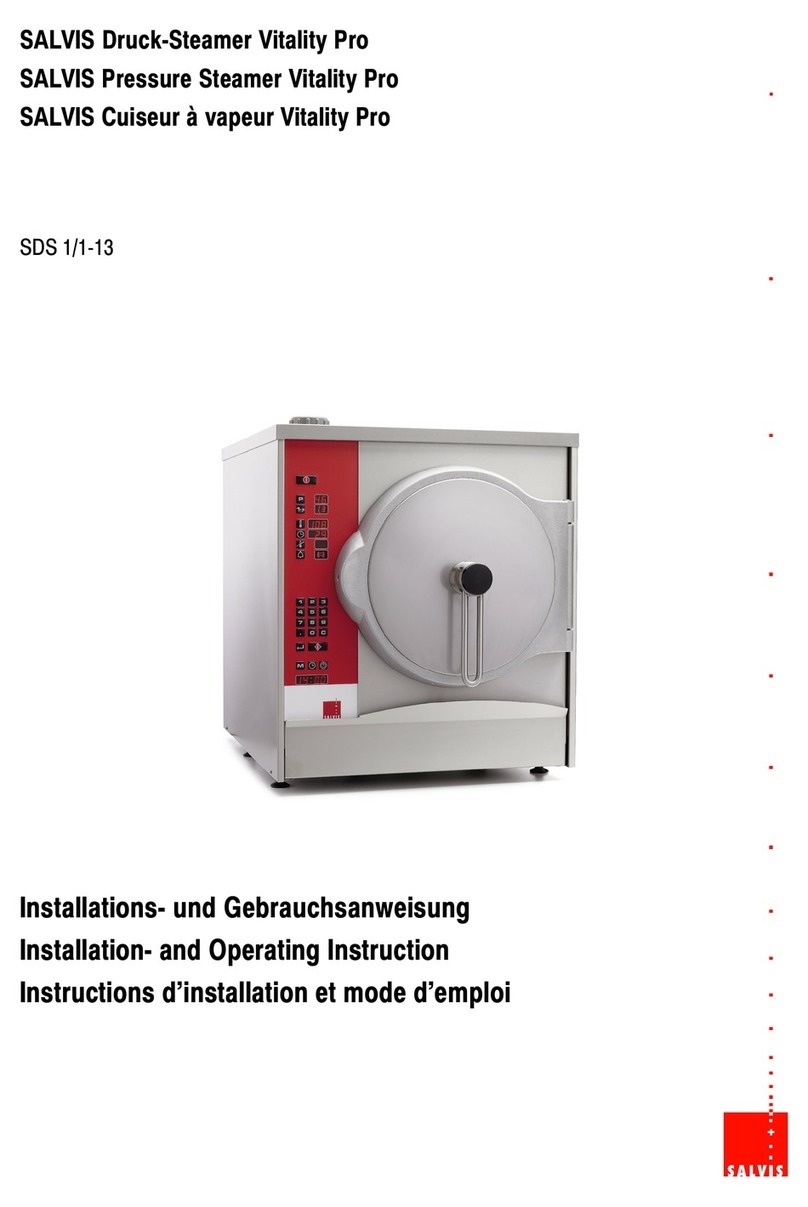
Salvis
Salvis Vitality Pro SDS 1/1-13 User guide

Salvis
Salvis ProfiLine Griddle plate 600 User manual
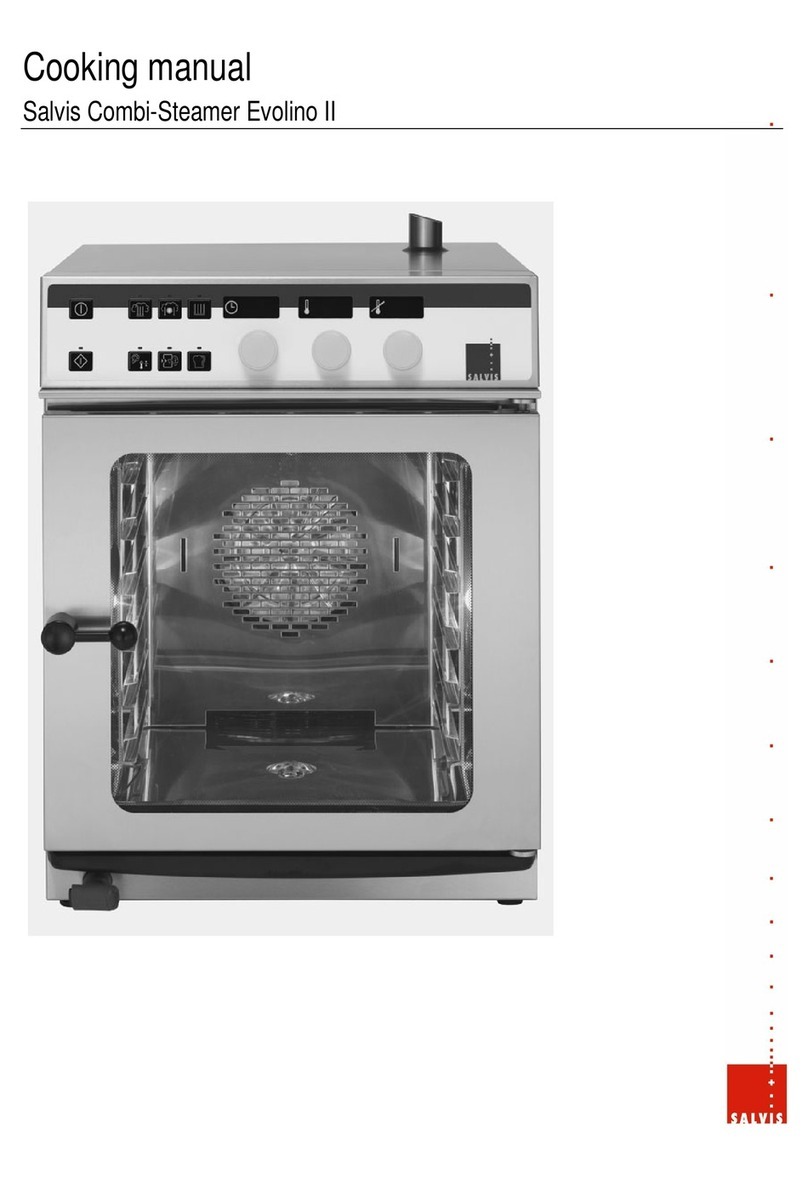
Salvis
Salvis Evolino II User manual
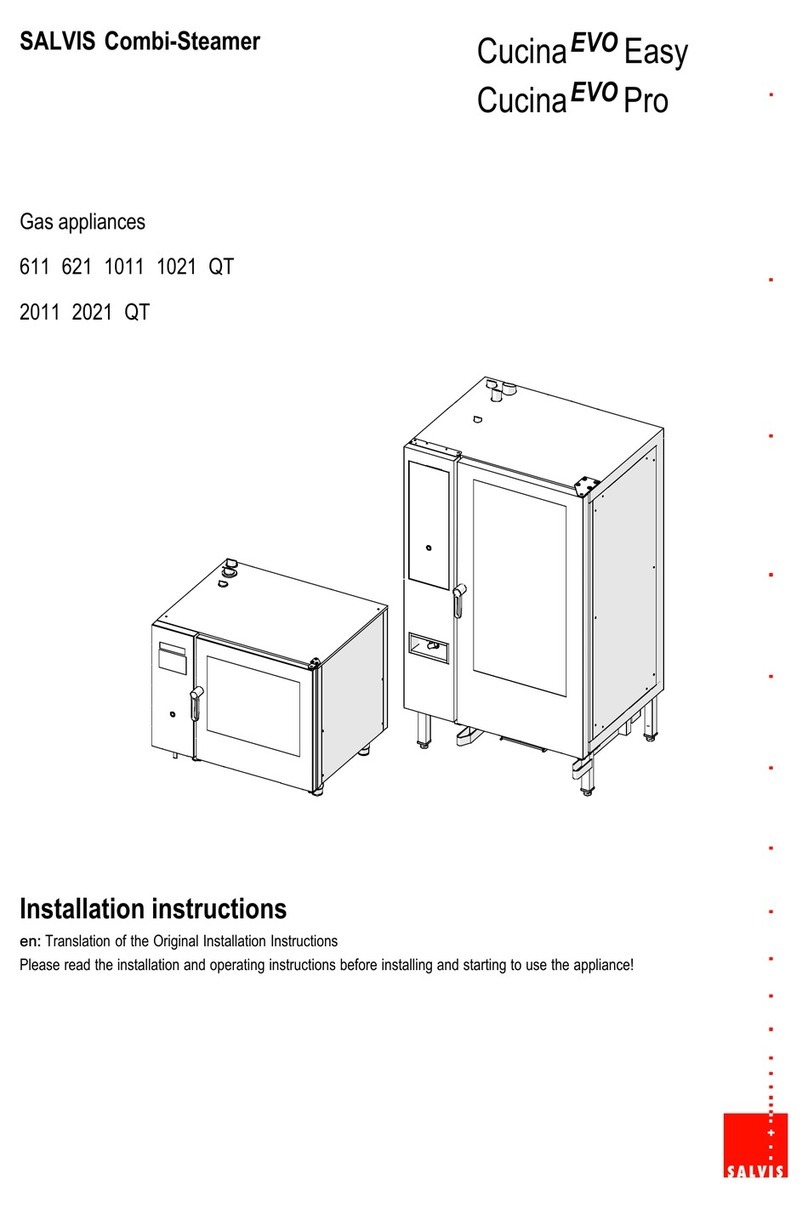
Salvis
Salvis Cucina Evo Easy Series User manual
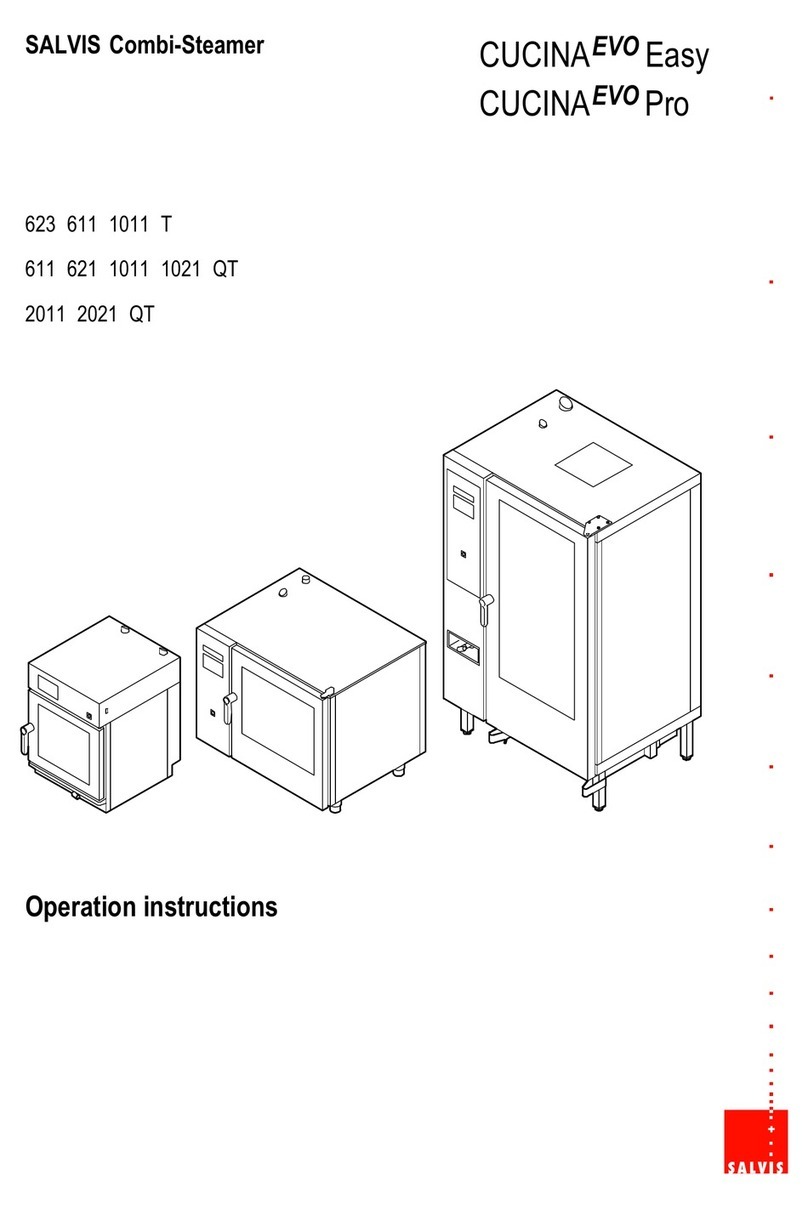
Salvis
Salvis CucinaEVO 623T User manual
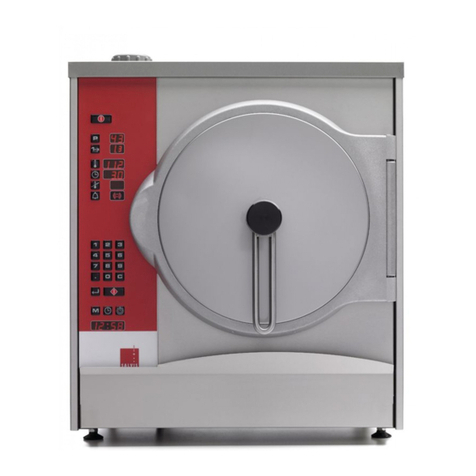
Salvis
Salvis FS 1/1 P User manual
